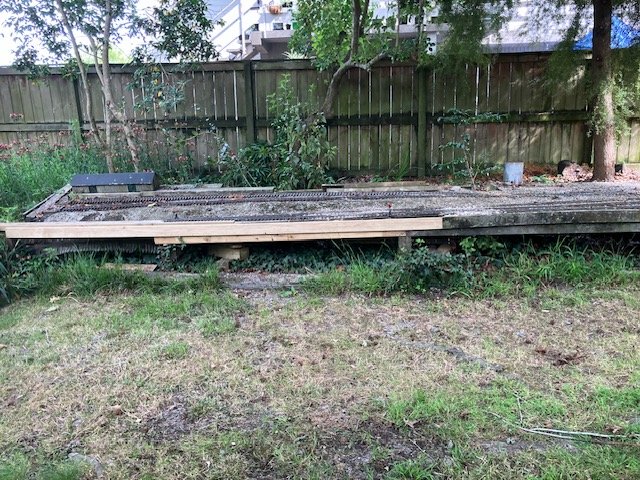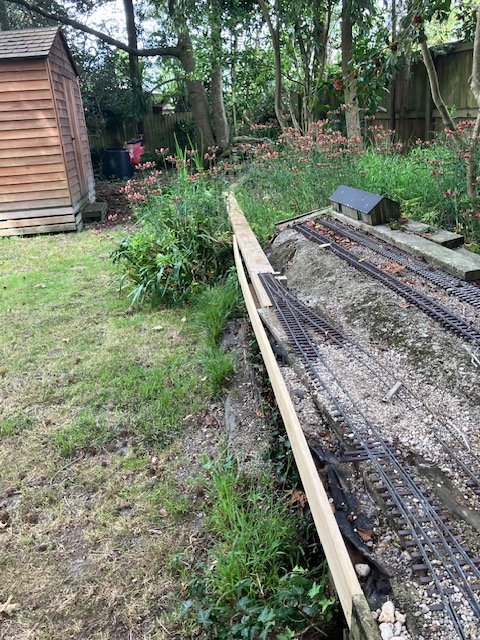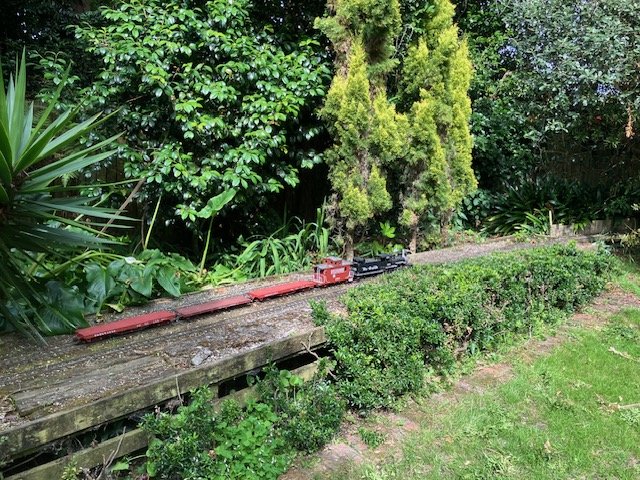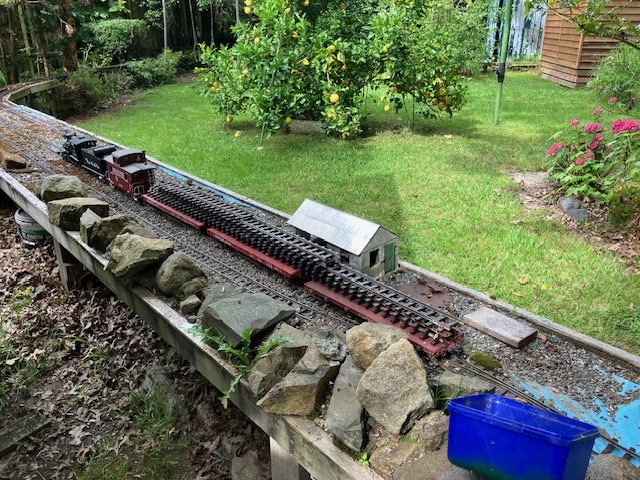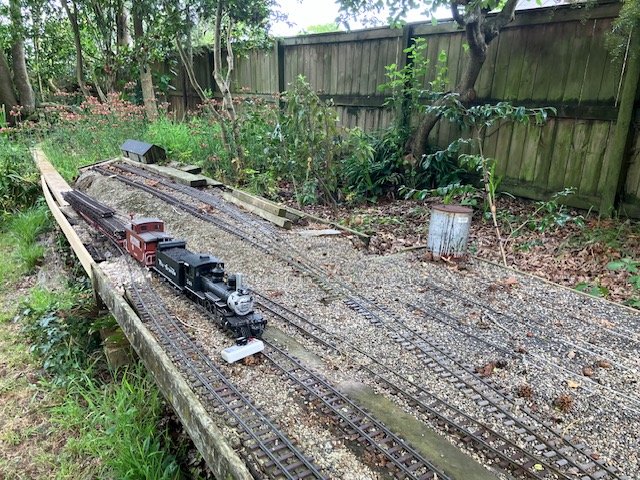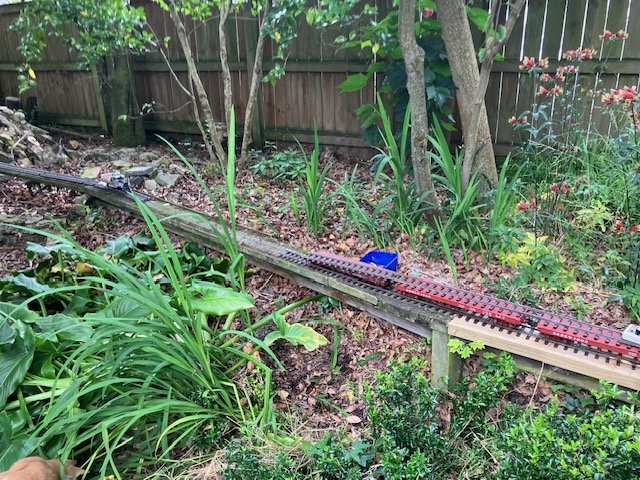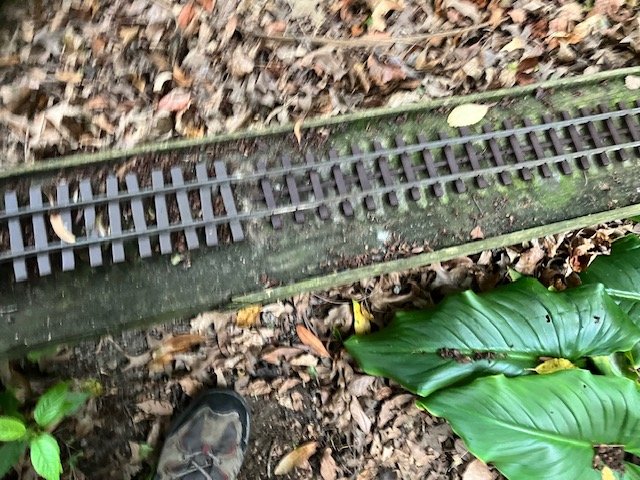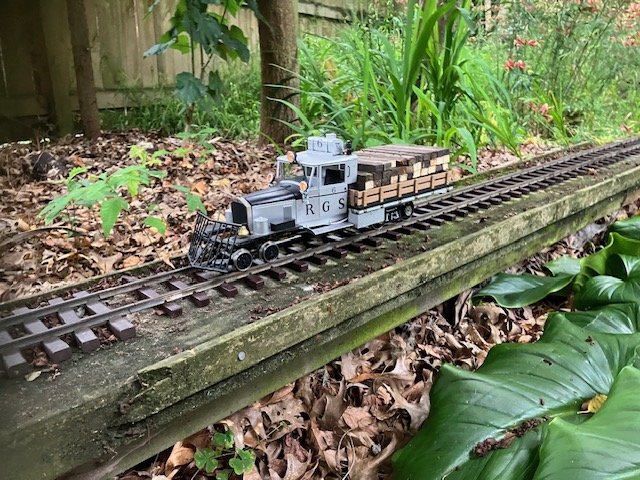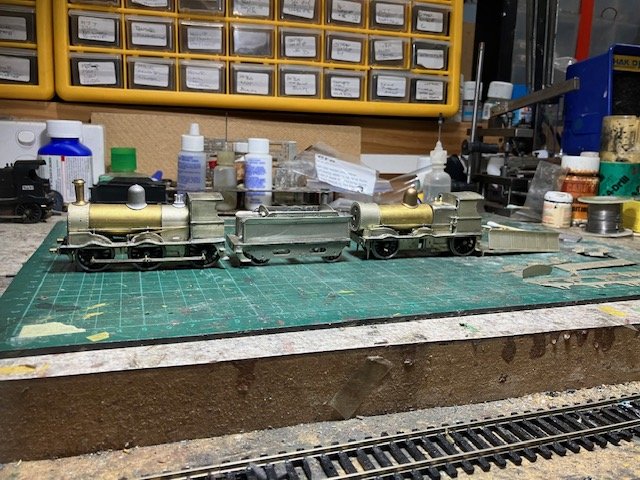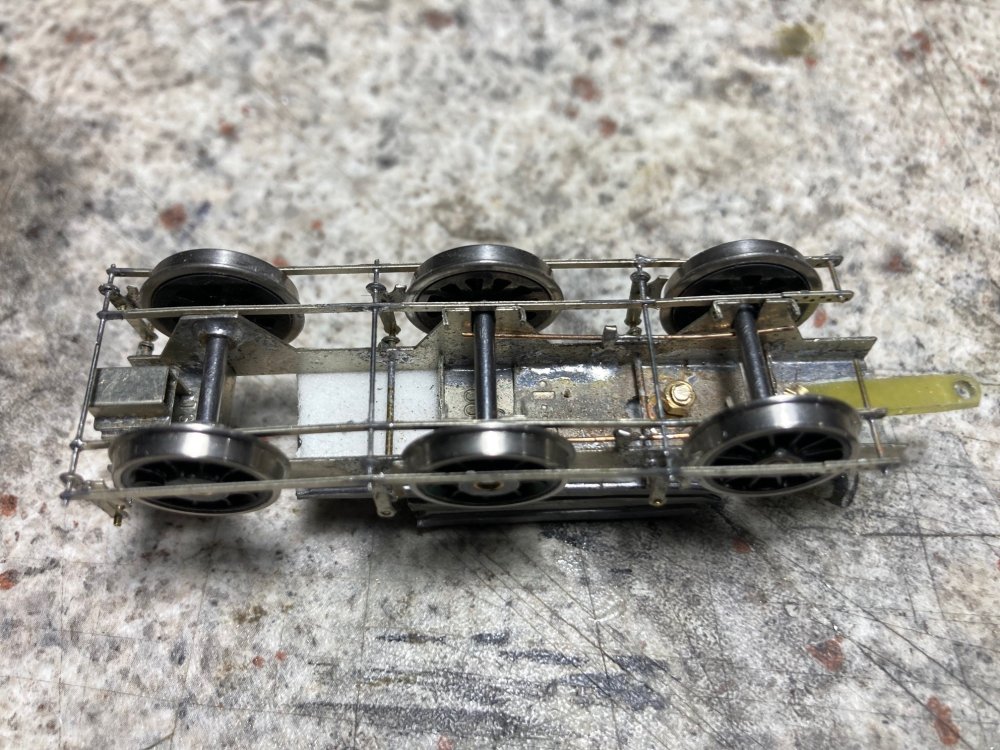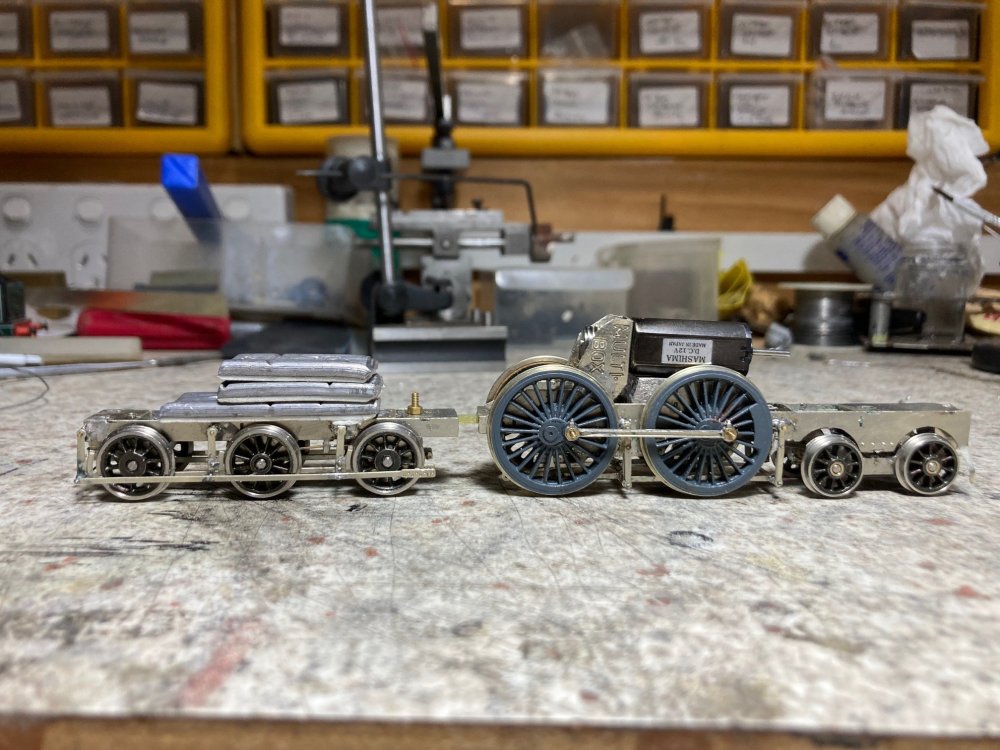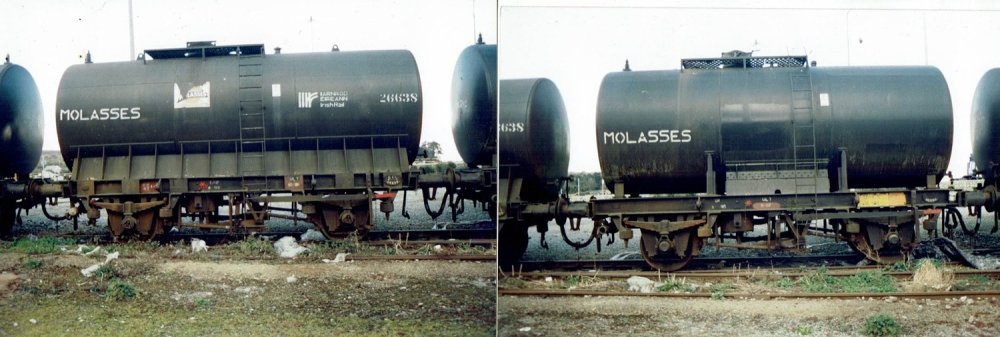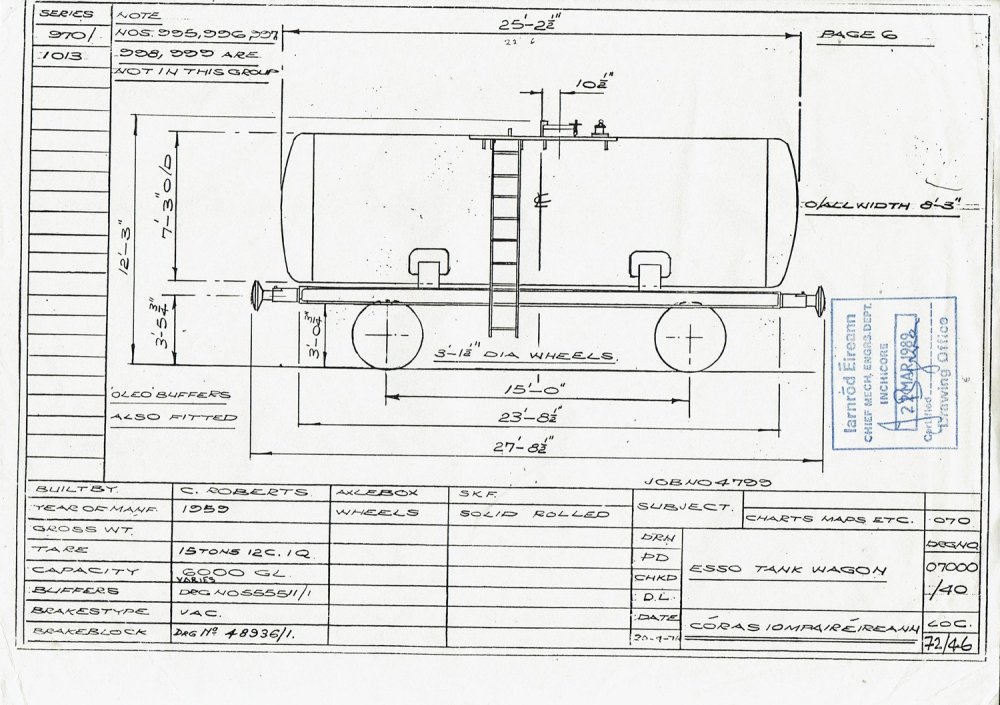-
Posts
4,851 -
Joined
-
Last visited
-
Days Won
119
Content Type
Profiles
Forums
Events
Gallery
Blogs
Store
Community Map
Everything posted by Mayner
-
Think GSR 800 may have been thinking of one of the early GNR railcars A diesel version of Cyril Frys streamlined model of Drumm Train C would have looked impressive. The as built styling of Trains C & D is remarkably similar to the LMS articulated railcar also introduced 1939 https://en.wikipedia.org/wiki/LMS_railcars#/media/File:LMS_Diesel_Multiple_Unit_80000–80002.jpg Interestingtly mechanically the LMS articulated railcar appears to have been a development of NCC railcars 2-4, GSR tended to buy Leyland trucks and buses so potentially access to the technology if there was a will. Everything is interrelated as they say, when I first arrived in New Zealand a Maori colleague asked what part of Ireland I was from and replied that his daughter worked in the IFC in Dublin when I told him.
-
The GWR, Midland and GSWR would have been concerned/alarmed by a LNWR being involved in a merger of the MGWR & GNR and possibly a Government (Westminster) and local interests (particularly Sligo) at the mergers impact on competition in a laissez-faire era when the railways had an effective monopoly on surface transportation before the onset of large scale competition by motor vehicle. The Free State took a very centralised approach to government including reducing the power of Local Government to make decisions which was also reflected in the Amalgamation of the railways into the GSR and the establishment of ESB, Sugar Company & BNM, where more localised decision making would have been more effective. In the UK Councils/Cities retained responsibility for their Tram and Bus networks. Interestingly while the GSR held its board meetings at Kingsbridge, the GNR alternated Board meetings between Amien St Dublin and Gt Victoria St Belfast which may have reflected a more devolved level of decision making that the GSR While apart from the Drumm Battery Train (driven by political pressure) and limited use of Steam Railcars the GSR was conservative in its approach to passenger rail operation, the GNR introduced diesel railcars and railbuses to improve services and reduce operating costs on marginal lines, the CDJR and SLNCR largely largely replaced steam hauled passenger services with railcars/railbusses. While apart from Ballybay-Carrickmacross the majority of GN lines in the Republic retained their (relatively frequent by Irish stds) passenger services until the late 50s the majority of branch lines in the South lost their passenger services between 1930 and the 47 fuel crisis. The branch lines lines that remained ran 1-2 passenger/mixed trains daily until closed in the late 50s-mid 70s. I think one of the possible drivers behind the Clifden, Achill and Killala closures was that the construction of the lines was largely funded by Government grant and their closure did not involve a significant write off of capital potentially affecting GSRs borrowing powers at a time the railway was building new 'modern' coaches and had began design work on the 800s. The closure of the three lines in the West is in startling contrast to the survival of the Kenmare and Valencia lines though CIE failed to exploit the tourist potential of either line with reasonable rolling stock or a reasonable passenger service. An diesel powered version of the Drumm Battery train would have made an excellent 'Tourist Train'/observation car for the Kerry or West of Ireland branches, interestingly CIEs 1st diesel programme included railcar set specifically for "Tourist" traffic. Probably better to go totally freelance than model a particular prototype in my teens I drempt up totally freelance railway systems both in Ireland and England complete with their own history and designs of locos and stock
-
I won't be proceeding with the Wagon Kits at this stage as I did not receive sufficient enquiries to proceed to production. One potential customer commented that the owner of a British Outline manufacturer (that has produced high quality kits in 4mm since 1972) said that 'people say they will wait until it comes out RTR" than assemble a kit. John
-
To me the big question is what would the LNWR have gained by absorbing the MGWR as a high proportion of cross-channel passenger and goods traffic from the Midland was already routed by the LNWR's North Wall-Holyhead sea route. The LNWRs involvement in Irish railway companies were hardly the most successful, the DNGR struggled to make a profit and passenger sailings on the Greenore-Holyhead route ceased in 1926, the GNR taking over maintenance and operation of the DNGR in 1933 the British Transport Comission closing the line in 1951. The LNWR became a major supporter of the DSER contributing a load of £100k to complete the New Ross-Waterford extension and paid a "virtual' annual subsidy of £20k to the DSER. The DSER plagued by tramway competition on its suburban services to Dunlaoire and Dalkey and coastal erosion the DSER paid a 1% dividend on its ordinary shares in the years before the Amalgamation. Its likely that the Midland would have been in a strong position in any negotions with the LNWR, Sir Walter Nugent the Midland Chairman became the 1st GSR Chair and Midland Officers took charge of GSR financial management, with a strong focus on cost reduction including singling double track sections of ex-MGWR lines. The other interesting one is the Baronially Guaranteed narrow and broad gauge line, where effectively the GSR was forced to swallow a 'poison pill" by absorbing the lines with the Free State continuing the guarantee ( guaranteed return on capital and making up of operating losses) for a period of 10 years. The GSR absorbing the lines would have been popular with ratepayers in the affected areas, immediately relieving them of the burden of supporting a railway that 'could not pay its way", but transferred the burden to an already struggling GSR after 10 years. The GSR lost no time in closing marginal branch lines after the 10 year guarantee period ended. A better option might have been to continue the status quo with Baronial Guaranteed lines continuing under local management and allowing the local community (ratepayers) decide whether to close the line or continue paying the guarantee, a number of lines including the Dublin & Blessington (outside GSR), Tralee & Dingle and Schull and Skibereen were operated by a Management Committee appointed by the Local Council. In Northern Ireland local control of the Clogher Valley was particularly effective under the leadership of Henry Forbes (of CDR fame) train services were improved and operating costs introduced as a result of the introduction of a diesel railcar & 'The Unit". The Stormont Government agreed to 'buy out' the shareholders and fund road improvements when the railway ceased to fulfill a useful function.
-

Claremorris Train Crash September 1989
Mayner replied to Noel's topic in What's happening on the network?
One of the more interesting aspects of the collision was that the farmer had apparrently adapted the practice of moving stock along the line between scheduled services and was caught unawares by the Knock Special. The reports into the derailment of the Knock Special and the 93 Knockcrockery derailments on the Mayo Line are not available on the RAIU website but should be discoverable under freedom of information. The whole business of Government(Ministerial) knowledge of CIEs concerns with the crashworthiness of older coaching stock is an interesting one and in this day and age would warrant Government Ministers, Senior Civil Servants and CIE Board members being held to account. In Annual Reports and no doubt meetings with the Department of Transport the CIE Chairman raised serious concerns with the crashworthyness of existing stock and expressed frustration with the (FF) Governments failure to approve the construction of new stock. At the time CIE was persuing a joint venture with LHB to build railway coaches for its own use and export at Inchacore, the Transport Minister who represented Longford-Westmeath refused to approve the project. The MK3 project assembling BREL kitsets at Inchacore was approved following the Cherryville Junction collision by a FG Minister of Transport who represented the Ballyfermot Constituency where CIE & the Works was an important employer. Things could have turned out significantly different during the past 40 years if the Government had approved the CIE-LHB joint venture with GM locos hauling Continental rather than British outline stock, would Irish modellers have turned to HO rather than OO? -
One of the 1969 Journals as far as I recall, donated my collection of IRRS Journals to the Model Railway Society Of Ireland before I departed for NZ in 2004, perhaps MRSI or IRRS Libriarian may be able to help. Another oddity during the late 60s/early 70s CIE shipped several trainloads of export sugar (for Nigeria) in 8'6" containers on 4w Flat Wagons from the Carlow Sugar Factory to Dublin Port as out of gauge loads. Presumably CIE would have checked clearances beforehand and imposed speed restrictions at overbridges & other structures where clearances were tight.
-
There is a very good article on CIE freight modernisation programme appeared in an IRRS Journal (1969?) written by one of the engineers/managers in charge of the programme. CIE designed and built a small number of hopper containers to carry grain (malt) traffic for a particular customer. CIE would have preferred to have used a conventional bulk container that could be discharged by tipping (from a truck), but had to go for a hopper with bottom discharge due to height restrictions at the customers premises. Traffic appears to have originated in Tralee as there are several photos of cuts of wagons with these containers in the North Kerry Yard, traffic appears to have been short lived and had ceased by the 1980s
-
Apparently in Midland days 'the authorities' became alarmed with very fast running(speeding?) of the 'Night Mail' from Sligo regularly arriving in Mullingar ahead of schedule. Reminders & notices to run to schedule appeared to have no effect, eventually departure from Sligo was delayed so that crews could not make it to Mullingar before pub closing time. Although running speed was unlikely to have exceeded 40-50mph with short wheelbase 4w non-passenger stock of the day (8'6" wb Horseboxes & Vans) running must have been pretty lively, particularly before the 1920s relay of the Sligo Road with 60' rails on baseplates that saw the line through until re-laid with CWR in the 1990s. Going back to the Esso oil trains, I one saw a laden oil train stabled on a siding at Maynooth on a Saturday morning late 90s/early 2000s. Spoke briefly to a driver who had taken it from the North Wall, who did not know when the train was likely to depart for Sligo. Reminded me of the American practice of a Yard Crew would make up a train and then move it to a location well clear of the yard to be picked up by a Road Crew who would arrive by Crewbus or Taxi.
-
The springs/suspension of the Heljan model like the Airfix/Dapol kit appears to be based on the original late 1950s fittings, from the early 1960s onwards wagons appear to have been fitted/built with modified suspension with spring dampers. The ESSO tank wagons used in Ireland appear to have spring dampers. Paul Bartell's pages of ESSO Vac Braked tank wagons includes photos of wagons with original 1959 and modified 1960s suspension and how the wagons weathered in service, he also has a page on ESSO tank cars converted to carry bitumen. https://paulbartlett.zenfolio.com/essoatankwagonvb The Bachmann "ESSO" tank wagon is a model of a larger 1960s built airbraked tank wagon which effectively rendered the 1959 designed tank wagons obsolete, freeing up a batch of wagons for use in Ireland to replace older loose coupled ESSO tank wagons.
-
General layout, quality and fit of the castings is remarkably similar to the whitemetal CIE 001 kit supplied by Model Irish Railways (Portadown) during the 1990s. The 001 in supertrain livery as 018 powered with Athearn SD drive parts mounted on a simple scracthbuilt brass frame/chassis was one of my pride and joys at the time. At the time some modellers were re-powering British outline 6 axle diesels (possibly Class 31 & 47 )with Atheran PA1 chassis.
-
Livery wise the IRM ESSO tank wagons appear correct from Mid-1980s onwards with max speed of 35mph, addition of Hazchem markings are reflector stripes on tank ends & tanks with modified bracing There are two Seanus Lattimir photos dated Aug 86 of 1003 in this condition at Mullingar the tank retaining lugs for the Esso shield in the IRRS Flickr collection. https://www.flickr.com/photos/irishrailwayarchive/53509330394/in/album-72157661623942928 Interestingly there is a July 72 Tom Wall photo of an ex-works (possibly Chas Roberts) photo of 994 at Inchacore in as introduced condition with ESSO shield & electrification warning on a grey tank body & top of underframe original tank mounts, black underframe (incl buffers) red solebars and yellow roller bearing caps. https://www.flickr.com/photos/irishrailwayarchive/53511632134/in/album-72157661623942928 There is a Paddy O'Brien a Mar 74 photo of 998 and other tank wagons in this livery at Claremorris. The ammended tank bracing appears to be a 1980s modification, there is a 1979 photo of the Oranmore-Claremorris oil train in JHB & Barry Carse 'Rails in the West" with the original tank bracing and withoutout reflective strips on the tank barrels. Modifications including ammended tank bracking and ammendments to the tank barrel are likely to have been carried out on a phased bassis when wagons were undergoing scheduled heavy repairs in the Works. Some of the wagons may never have carried the ESSO logo or plate while in service in Ireland, there are several Paul Bartell photos of the wagons in service in the UK with lugs no logo or plate. ESSO tank barrels with lugs no plates were stored for several years during the 1970s in the "Railway Village" outside The Works.
-
Extremely frustration, I am in much the same situation I converted our garage into a railway room about 10 years ago and for one reason I have been unable to find time to build a layout, sometimes the unexpected happens and things do not go to plan! Have you though of asking friends or the model railway community if anyone would be interested in helping out? Sometimes private layouts are colloborative efforts where people help out with the build and operation, sometimes people travelling quite a distance to help out. Several years ago I helped friends with baseboards and carry out tracklaying on their layouts one involving a 3 hr round trip. Nearer home the owner of the Greystones layout exhibited in the 90s, built and exhibited the layout with the assistance of a group of friends and in Scotland Richard Chowns 7mm Waterford Limerick & Western Castle Rackrent layout was operated by a group of operators who regularly travelled to operating sessions on the layout before his death several years ago.
-
Interesting a location where very little changed in almost 100 years followed by significant change in the last 20 or so years/ The layout basically remained un-changed from era the Dardanells Sidings (area on the right) were laid presumabably in the WW1 eara until the yard was re-modelled about 20 years ago. The one constant feature is the double slip on the crossover from the main running lines to the Granary Sidings & Alexandra Road Tramway. The running lines from Chruch Road Junction were once fully signalled controlled by the Granary and Sheriff Street signal cabins. The Dardanell's sidings and the remains of the Point (Polling Fields) yard were lifted and re-modelled to handle the reaining Liner trains (mainly keg traffic). Railborne Container traffic to Dublin Port had earlier ceased following the closure of the recently (1996?) opened rail terminal at the end of the Alexandra Rd terminal and transfer of traffic to a terminal South of the Liffey The Dardanells and the Polling Fields had been used mainly used to store stock awaiting repair in the adjacent wagon reapair shop or long term store/dump for out of service stock, some gems included the remaining ex-DSE coach & GSWR vans once in departmental service and a collection of redundant private owner tank wagons, stock that may not ahve turned a wheel in over 20 years, ironically the proposed hard stranding for container transfers to the Port appears to be partially on the site of CIEs original Point Depot (Polling Fields) container depot opened during the late 60s We have been here before Devestation at the Holyhead Yard 2003 Irish Rail final days of container operation July 2005 12:00 Cork Liner on left, Ballina Liner on right! No other destinations serve
-
The speed limit of the ESSO tank wagons appears to have been progressive reduced from 50 to 35mph in response to de-railments of empty ESSO tank wagons at Donamon & Moyvalley. Similar restrictions were imposed on other types of 4w wagon, I had a painting diagram of the 22'6" Flats used for Asahi Acrylonitrile traffic which indicates that the maximum speed was progressively reduced from 50 to 40 to 35mph. The effect on passenger train schedules would have been minimal as apart from the Cork Line trains speeds and frequency had not increased since the 1970s. On the Sligo and Mayo Lines the main issue was the easing of schedules due to an increasing number or speed restrictions as a result of deferred track maintenance from the late 70s onwards. The down ESSO & Claremorris Liners tended tended to depart Dublin in the evening after the departure of evening Sligo & Heuston passenger services and return in the mornings in the quiet period between morning arrivals from the provinces and early afternoon departures from Dublin. Interestingly the Foynes-Ballina Asahi Oil & Coal trains (35mph 4w wagons) were scheduled to operate via the Nenagh branch (when the Limerick-Claremorris line was out of service during the mid 1990s) rather than via Limerick Junction in order to avoid delaying up Cork line passenger trains scheduled to operate at up to 100mph.
-
0.4n/s I tend to build OO Gauge 2-4-0s with a rigid chassis (making sure the leading axle is free running) and hopefully some day will get around to completing a 21mm gauge compensated version or two for myself.
-
Breakhrough! A real and unexpected breakthrough today after nearly 6 months I relaid the track lifted almost 6 months ago and I can once again run trains on the garden railway. Although I had replaced a decayed section of trackbase by late July, a section of the supporting structure required replacement and did not have time to carry out this work until December. While the piles and beams that support the trackbase held up well, the end of one of the 4"X2" that supports the trackbase in the station/yard area was quite badly rotted and replaced with new treated timber (centre of picture) the cut ends were given an additional coat of clear preservative. I replaced the basebord fascia in this area (4"x1") decking timber to provide a uniform appearance in this area. Looking into the jungle, we had high rainfall and humid conditions this spring and with little time available the garden got away on me! First Train since June! 346 with a train of Flat Cars and Caboose to pick up track material. I haden't planned to work on the railway today the arthritis in my knees began playing up quite badly on Monday and I found it painful and difficult to walk yesterday, but thought some exercise might help and it did! Picked up refurbished track panels had sat on the outdoor workbench since June, just for show as load toppled on 1st curve. Material train at the "head of steel" (brass actually) RGS Motor 6 waits at the other end of the gap before we drop in the last panel. Track reinstated! The track panels overlapped by about 2" though I am fairly sure I used the original rails! Problem quickly solved with a razor saw, could not find my junior hacksaw and blade nackered on full size hacksaw. New Sunset Valley NG ties are shorter than original Accucraft (AMS) NG ties but likely to last longer. I have enough Sunset Valley ties in stock to replace the remaining AMS (American Model Systems) ties on the main line, but will probably have to replace the AMS ties on the "High Line" that are showing signs of UV damage 18 years use and Southern Hemisphere UV exposure. Motor 6 carried out the first test/inspection run. 346 followed after marshalling the Caboose at the end of the train, it was after 8pm and the light beginning to fade. More a setting of priorities a toss up between assembling a 60Class D14 etch I drew up last January and completing a pair of SSM J15s I started only God knows when. I recently tidied up the workbench and began sorting out the parts for the two locos and just maybe make some progress before starting the D14
-
Fair play Harry I have been planning to build a fleet of Midland engines since I was a teenager and it took me 40 years and several false starts to build a successful Ks/650 Class. I still have wheelsets stashed away for a Cattle Engine, Standard Goods, 650 & Achill Bogie. Fitting B1 wheels under a D16/3 (Hornby ?) is a nice bit of latteral thinking as its becoming increasingly difficult to source loco driving wheels from traditional sources like Markits & AGW. Having used a professional 3D modeller to design most of my 3D models, Killan's fee for designing the A Class appears reasonable. By the way 544 in the photo of the train arriving at Broadstone is one of the ligher/shorer C Class equally deserving of being modelled I am heavily comitted to 21mm gauge and working in metal, but its looking increasingly unlikely at this stage that I will get around to building a 21mm layout and may have to compromise on OO to build a layout. Well done for showing such initiative
-
Layer lines (on both sides) particular on models with smooth sides/surfaces seems to be a common problem with desktop printers. It would be worth checking whether there is an on-line Support Group for your particular brand of printer. I ran into similar problems with an Anycubic printer and found their Facebook Support Group helpful. Problem appears related to the lubrication of the slides & screw that raises and lowers the build plate, but was unable to satisfactorily resolve the problem for model railway stock or buildings and use a print bureau for railway rolling stock. Printer appears to work fine for human, animal and fantasy figures with irregular surfaces.
-

Ernies Massive Irish 1930's to 2005 Photo Archive
Mayner replied to Glenderg's topic in Photos & Videos of the Prototype
There is a story of Bulleid explaining his concept of a fireless main-line loco to a group of workers during an after dinner strole around the Tender Shop during his early days at Inchacore. It appear the guys asked Bullied about his plans for a new loco and he drew up a sketch (concept drawing) of a fireless loco that would be 'topped up' at a series of charging stations around the network. I guess we will never know whether there is some truth to the story. The ESB substantially increased it power generation capacity from Hydro and Peat from the late 40s onwards against a background of economic stagnation and a falling population. The railways may have been seen as a means of absorbing some of the additional capacity in the same way as the GSR was enticed (manipulated) into building the Drumm Battery trains by the offer of 'cheap electricity' from the Shannon Scheme. Whatever about fireless locos topped up by lineside generating plants, development of the Drumm principal with partial electrification would have been feasible and fitted in with the social and economic aspirations of the 1st 'Inter-party' Government elected in 1948 (Declare a Republic, attempt to set up a 'Welfare State" (Mother and Child scheme) based on the UK model, and lay groundwork for the Republics economic transformation from the 60s onwards. A change from a railway a railway that mainly exported cattle and people, to one that carried mineral and manufacturing outputs to the ports from the 60s to the 90s to the contemporary railway that mainly transports commuters to their offices in the cities. Faced with the reality of a stagnant economy, the railway worsening financial position, CIE had to modernise 'on the cheap" with diesel traction and cheaply built stock good for 20 or so years. Still at the end of the day a modern variant of Drumm's Battery trains are likely to resume operation in Ireland over 90 years after the initial trials on the GSR. -
Its difficult to envisage countries with a much lower population density than countries such as France, Germany or the Benelux Countries replacing air and long car journeys with European-style passenger rail services. Ireland has a low population density at 76 people per Sq/Km compared with France 120Sq/Km, Germany 243, England 297 and less urbanised at 60% compared with Western European countries at over 80%. More likely a citizens revolt over having to pay high taxes and rates to subsidies public transport, rather than conspiracy theories about Socialist Governments forcing us to use rail or motor industry Hit-men. I very much doubt that the Irish public would be prepared to pay the high level of fares or taxes required to support a high speed/high frequency European passenger rail service. The New Zealand Transport Minister recently advised Wellington and Auckland cities that they will have to substantially increase train and bus fares as farebox revenue in both cities in now below 25% of operating costs. Farebox revenue in cities such as Vienna and Oslo contributed 50% revenue pre-Covid and in many countries commuter rail passenger numbers have not returned to pre-Covid levels as working patterns have changed considerably since the 1980s. Strangely much of the current push for people to resume commuting and return to their office is driven by Financial Institutions with a major risk of ending up with 'stranded assets' as city center office blocks, business districts and transport assets become redundant if people no longer need to commute to the city to work. Although there has been a lot of talk about 'remote work' and people working from home being a post Covid thing, I worked largely remotely for an Irish Government agency for two years before leaving for New Zealand in 2004. These days I pay almost twice as much in rates on our house as in income tax. A high proportion of our rates goes towards maintaining the local roads and subsidising local public transport services (which I don't use)
-

Ernies Massive Irish 1930's to 2005 Photo Archive
Mayner replied to Glenderg's topic in Photos & Videos of the Prototype
Interestingly some of the large Coey era GSWR 4-4-0s retained tapered boilers until rebuilt by the GSR with superheated boilers during the 1930s. Apparently tapered boilers were introduced during the 1900s to keep the axleloading of the 321 and 333 Class 4-4-0s within the Civil Engineers limits. Some of the 4-4-0s were rebuilt before the (1925) Amalgamation with new heavier frames, but retaining the original tapered boilers after axle loading was increased following the re-laying of the Main Line. The 800 Class & Drumm Battery trains. There was certainly an element of national pride in the 800 Class and Drumm Trains C&D also introduced 1939. C&D had a modern contemporary appearance not unlike the LMS Leyland articulated railcar set trialed on the Oxford-Cambridge line around the same time. C&D were let down by using refurbished batteries from the original Drumm trains A&B, the refurbished batteries becoming life expired after approx 5 years. -

Ernies Massive Irish 1930's to 2005 Photo Archive
Mayner replied to Glenderg's topic in Photos & Videos of the Prototype
According to A Decade of Steam RPSI 1972 and Locomotives of the GSR 401 reverted to Walscherts valve gear in 1949 possibly to provide parts to keep 406 running, but I haven't seen photos of 401 in2 clinder form with Walscherts gear. W McDonnell Running Foreman Cork wrote the section of the 4-6-0 in a Decade of Steam from an enginemans perspective and considered 402 the "best of the class" as the most powerful and reliable. In practical terms 402 and the two Caprotti valve gear engines 401 and 406 were practically new locomotives when rebuilt with new frames, cylinders, wheel centres and motion. 402 was basically an express passenger version of the 500 Class originally introduced as a mixed traffic loco. The 800 Class may have been as much a prestigious project to demonstrate the Free States technical and engineering ability as well a its traffic needs in a similar manner to the Drumm Battery Trains. Apparrently the 800 Class were fitted with parrallel boilers with tapered cladding which would have contributed to the similarity in general appearance between the Rebuilt-Royal Scots LMS and GSR 800 Class -
A Jan 2024 Irish Times article paints quite a different picture with the Dublin Port Company downplaying increased rail usage in its expansion plans and the Transport Minister Michael Martin 'encouraging' the Port Company to make increased use of rail, including a instruction to model (carry out a feasibility study) of railing container traffic between the IE North Wall Depot to an 'alternative site" (Inland Port) outside of the Port. https://www.irishtimes.com/ireland/dublin/2024/01/17/dublin-port-downplays-increased-role-for-rail-freight-in-expansion-plans-despite-ryans-concerns/ The Port's argument appears to be that rail traffic through the Port has been falling and that "de-carbonisation" may be achieved more quickly and effectively with 'low-emission" trucks through the Port Tunnel & Motorway network. As far as I recall there was talk of Dublin Port closing rail access to the Alexandra Road Terminal at some stage this year in order to improve road access to the terminal through a flyover (for trucks) over Alexandra Road.
-
I locate the two front axles in slots in all my 2-4-0s and 4-4-0s, added weight at the front of the tender and found that it works fine. I copied the idea of using slots from the TMD/SSM GNR S Class tender as a practical way of assembling/building a "Sharman Free Tender" and it seems to work quite well. 2-4-0s and 4-4-0s I have built successfully hauled 15 IRM Ballast wagons of 10 of my heavier less free-running 3D printed wagons
-
Two wagons were introduced in red & white for petrol and four in blue for fuel oil traffic between the Burmah Tivoli and Limerick terminals. The red and white Burmah scheme appears to have been a variation of the red stripe on a silver or light grey tank tank barrel for hazard Class A (highly flammable liquids) tank wagons. Nice to see a page from the CIE Railfreight diagram book, I got to have a look at it a couple of times in the 70s. It would be great if the Diagram Book was made available throught the IRRS or published as it included both diagrams and photos of wagons, containers and swapbodies in service at the time. The Burmah tank wagons were used for Mollasses traffic in the 1990s along with tank wagons originally introduced for Oil from Foynes to the Limerick and Drogheda cement factories during the 60s. Although on a similar 20T vac braked chassis the "Irish Cement" tank wagons appeared more conventional in design on a purpose built chassis the tanks having conventional anchor mountings. Mollasses Tank wagons stored Foynes c:2000. 26638 possibly built for Cork-Ballinacourty oil traffic similar design to Burmah Class B tanks. 26570-26589 series tank car introduced for Oil traffic to Cement Factories 1966. CIE Diagram Charles Roberts 1959 built ESSO Tank Wagon 970-1013. Interestingly diagram notes that 995-999 are not in this group.998 appears to have been a "Jumbo: Bitumen wagon, While the majority of ESSO tank wagons had the long barrel that extends over both ends of the underframe (headstock) I saw at least 1 wagon with the shorter tank barrel modelled in the Airfix and Dapol kits during a visit to East Wall yard but was more interested in the older tank wagons stored/dumped in the yard at the time and did not take photos or numbers!
.png.c363cdf5c3fb7955cd92a55eb6dbbae0.png)










